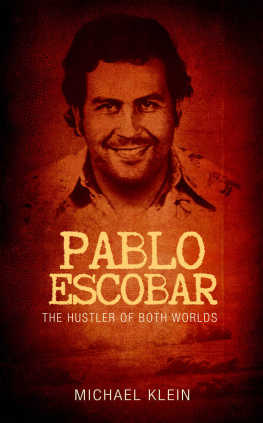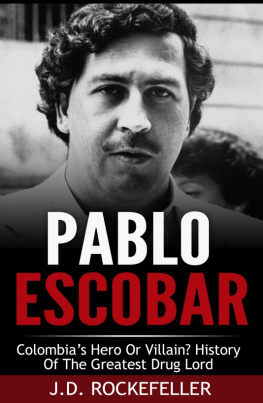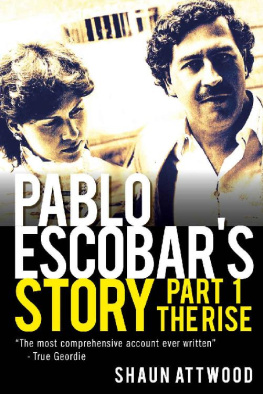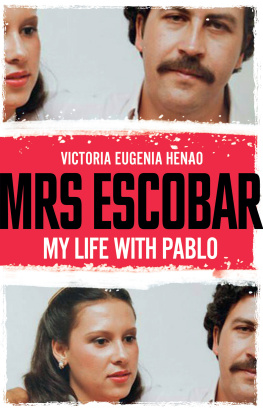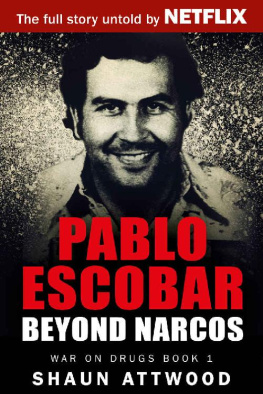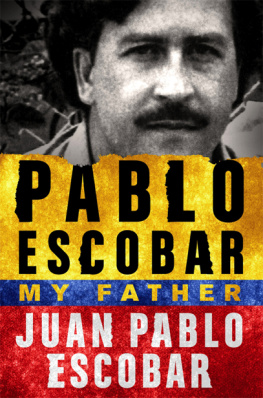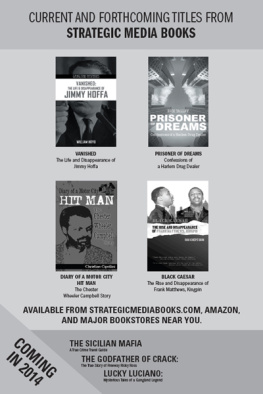Pablo Escobar: The Hustler of Both Worlds
By Michael Klein
Copyright 2016 WE CANT BE BEAT LLC
Table of Contents
Chapter One: Spotting Opportunities: Colombia During and Before the 70s
Chapter One: Spotting Opportunities: Colombia During and Before the 70s
There are two hundred million idiots, manipulated by a million intelligent men.
- Pablo Escobar
The sicario would normally take his secret to the grave, honoring the cartel's code of silence, as he relentlessly shot up the back of the white Mercedes limousine from the back of his motorcycle. Easy to maneuver and terrifying to unaware dead men walking, the motorcycle had become a symbol of power to assassins hired to get rid of prominent drug lords' problems running from the law delivering their own variety of justice. It was 1984 at dusk in Bogota and the story didn't start in a New York club far away where a generally responsible person who partied hard and worked hard was doing a line in the bathroom.
The sicario wasn't working alone, especially if you consider the American narcos miles away waiting for news, distraught by all the latest political scrutiny on the business side of Colombian trafficking. They were the chosen--one killer and one driver--chosen by three field commanders from Los Quesitos, a Medellin murder gang that had taken the contract sponsored by the cartel to handle the Bogota-end of the assassination. To their bosses, riding on motorbikes had become the cheapest and most convenient mode of transport. To the people who they were licensed to kill, they became the most expensive misstep of their lives. The line between legal and illegal would blur for those on hit lists when they closed their eyes forever and took their last breath.
The machine gun bullets in the hands of a second Colombian sicario were meant for a mana political figure, who had become an unforgivable thorn in the side of drug traffickers, specifically Pablo Escobar. The man had publicly humiliated, crossed and denounced Escobar. He openly drove Escobar out of Congress with cartel involvement denunciations after relentlessly pursuing politicians who had taken hot money in elections. Escobar's low profile had allowed him a career as a public servant, but the man whose name was on every bullet in the sicario's MAC-10 had stepped everything up in his war with the cartel, including calling this spring offensive upon himself.
The very men who flooded Medellin's streets with money and bullets to secure tha transport of drugs to demanding markets overseas were on the offensive. This man had received intelligence. Knowing his days were numbered, he looked for a way out of surrendering to organized crime. Of course, it's always a matter of perspective when the stakes are high and the gamblers find themselves at the end of a sharp knife made not of metal but of ignominy.
With a high demand for jobs, there were billions of dollars to be fought over by those drawn to the dangerous underworld of illegal trafficking. Meanwhile, aside from the distraction of those making a traditional living, drug-related assassinations turned Medellin into the most murderous city in the world. April 30th may have become Children's Day in Colombia during the twenty-first century, but on this day in 1984, Justice Minister Rodrigo Lara Bonilla was shot dead point blank by two men, with one barely an adult and both employed by Pablo Escobar as sicarios. They would be chased through the streets. Lara Bonilla's attempts to secure safe passage with the help of US Ambassador Lewis Tambs after being notified of and escaping previous plots would be too little too late and immediately put to rest. He suffered from a lack of appreciation of the hornet's nests he had stirred.
Young impressionable minds had spoken beguilingly through hardcore poster-sized retellings of bandidos. These legends were the resolute whose daily reality lent itself to expanding on power-hungry outlaw traditions. Earn a few pesos living honestly or this? Often nonplussed by the alternatives and seduced by the narco-trafficking money and becoming sicarios, these once eager and willing six and seven year olds telling tales about the Escobars, the Ochoas, and bandidos of long ago were now realizing their roles in the shadowy world. Like the bandidos, they were forcing their way up in the world and imprinting themselves on minds. Resisting seemed an option, but masking thoughts and feelings, many would eventually try their own hand at building their own hardcore reputation and become numb to inflicting pain to turn a profit and get a slice of the narco-pie.
Byron de Jesus Velasquez Arenas would be captured, just a teenager. He was forced to break his code of silence as the driver. He told detectives that he'd been paid $20,000 to kill Mr. Rodrigo Lara Bonilla. Lara Bonilla had been attempting to secure a new diplomatic post in Czechoslovakia at the time. Byron was very young, Fernando Quijano, an organized crime investigator and director of Medellin-based human rights group Corpades said, and that had a strong impact.
"Carlos Mario," who had taken the shots that killed Lara Bonilla from the Yamaha motorcycle behind the right rear fender with his MAC-10 emptying the magazine, had delivered three 45-caliber slugs into the Minister of Justice's head, one in the neck, two in the chest and one in the arm. Although Arenas took a shot in the arm from a bodyguard as they chased down the Yamaha, thirty-one year old Carlos Mario, a.k.a. Ivan Dado Guizado, was dead in the street with his head barely attached on account of the bodyguard's deadly aim. Mario had fifteen prior convictions ranging from assault, robbery and murder. Not many sicarios in the business generally expect to live to the age of thirty and Carlos had made the extra year.
A little over thirty years later, Lara Bonilla's body would be exhumed when they reopened the murder probe. Investigators have found further evidence that suggests that state security agents may have colluded with the killers. Neither the driver nor the bodyguard were injured in the attack on the then-Minister of Justice and some have considered that the car may have been stopped allowing Lara Bonilla to be shot at close range. Still, the 1984 killing by Pablo Escobar's sicarios was considered the first in a string of slain politicians. While Escobar's legacy has been open to much debate, the role model he had that introduced to him the technique of using sicarios to flex their muscle and dominate, Griselda Blanco, would by this time have perfected the technique that would become associated with the drug trade in Colombia.
The transnational drug trade wasn't the exclusive domain of the Medellin traffickers in the seventies, but instead already had a few drug trafficking networks that were expanding from marijuana to cocaine. These included: the Cali networks that worked with Venezuelan, Sicilian and Mexican networks and the Cali cartel in the U.S. in Georgia and New York through Benjamin Herrera Zuleta and Helmer "Pacho" Herrera. The latter would later become Escobar's rival and facilitated his downfall with the Colombian government. Other networks included: Corsican connections; La Compania, a dominating Cuban organization in South Florida and five other states; Chilean traffickers until General Augusto Pinochet came to power; Jamaican traffickers smuggling bulk shipments through southern Florida, Canada and Great Britain; and the Colombians would get control over Peruvian and Bolivian producers (notably Roberto Suarez Gomez) and Chinese refineries.
Cali organizations had cooperated with Medellin cartels throughout the 1980s, where the Cali cartel predominantly controlled New York City markets and the Medellin cartels controlled the Florida markets, but as we will learn they never created a supercartel together and their relationship would sour. In the coming pages, we will look at how Colombia hitched itself securely to capitalize on the rise of cocaine, as leaders in the smuggling business saw that it was a much more profitable drug than marijuana. Pablo Escobar rose in the ranks far from the eyes of rich Colombians working in traditional businesses some of whom would come to see him as a bloodthirsty gangster.
Next page
